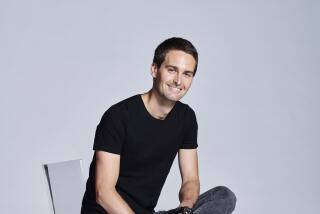Kixeye thrives on Facebook where others flail
Kixeye, a social game developer in San Francisco, doesn’t attract much attention -- and that perhaps provides a clue to how the company has managed to flourish on Facebook while others have wiped out or stalled.
Kixeye has little more than 5.3 million players a month on Facebook, according to Appdata.com. By contrast, Kixeye’s crosstown rival, Zynga, has 284 million. That makes Zynga the largest game publisher on Facebook, while Kixeye is much further down the list at No. 66. Kixeye’s biggest game, “War Commander,” has just 2.5 million players a month, compared with 58.8 million for Zynga’s “The Ville.”
But Kixeye has something Zynga does not -- two consecutive years of profitability in 2010 and 2011, and another one on the way for this calendar year. Zynga, meanwhile, posted a loss for its latest financial second quarter and lowered its expectations for the full year, citing Facebook’s “challenging” conditions, echoing the sentiment of many other developers over the rising cost of attracting new players on the social network.
Kixeye, on the other hand, holds the exact opposite view about Facebook. The 5-year-old company has quietly built a growing business, with revenue that’s expected to triple this year. The privately held firm declined to disclose its projected 2012 sales figures, but said they will hit “nine figures,” meaning at least $100 million.
More than 10% of Kixeye’s players end up spending money to play, compared with 1% to 4% for most other social game publishers. There are other attributes that set Kixeye apart from its rivals, and the company gleefully makes fun of those differences in a wickedly funny video entitled “ZombieCastleRescue.” (Bonus points if you can identify which competitors are referenced in the video.)
How did Kixeye succeed in the remorselessly Darwinian environment of Facebook? Will Harbin, Kixeye’s chief executive, and Brandon Barber, the company’s senior vice president of marketing, took some time to explain their formula in recent interviews with The Times. Here’s an edited transcript of the conversations.
Q: What’s so special about Kixeye’s games that brings such a high percentage of paying players?
Harbin: For one thing, our games are actually games. We spend a lot less time than other companies thinking up ways to get people to pay. We start with a core game loop that keeps people engaged. “Battle Pirates” is about building an empire and competing with other players to conquer new territory. It’s a tried and true genre. The more fun people have, the more they will play. And the more they play, the more likely they are to pay.
Q: What do they pay for?
Harbin: We don’t have any exclusive content that you have to spend real money on. Everything we have can be earned by playing the game. But if you want it sooner, you can pay for that instead of waiting. We simply monetize the impatience.
Q: Who are your players?
Barber: Between 97% and 98% of our players are male. On average, each of our players checks in three to four times a day for more than 30 minutes each session. They stay with each game for eight months on average, which is five times longer than most social games.
Q: What’s your formula for succeeding on Facebook?
Harbin: If you want to be a successful independent publisher, you have to master three basic things. The first is that you need a good game design. The game has to be fun. The second thing is to be able to iterate your game based on metrics, or feedback from your players. You have to treat your game like a service that you need to constantly improve for years to come.
And third, you need to know performance marketing. You have to know how to efficiently find players through targeted ad buying and other viral channels and be able to funnel players to your games. We have 1,000 ads running at any given second, each sliced and diced by age, gender, likes, affinities, and geographic location.
Q: How effective are the Facebook ads?
Harbin: We owe much of our success to the Facebook ad platform. It lets us target an infinite number of demographic combinations. Maybe 20% to 30% of our total population of players came to us by clicking on those ads. We’re working with Facebook to reach users who don’t click on ads.
Q: Facebook frequently changes its formula for choosing what to show its 900 million users in their feeds. These changes often tie developers in knots because they influence what people see and, therefore, what they click on, including games. How have these changes affected Kixeye?
Barber: Facebook is a dynamic platform. They make changes, we make changes. We look at those changes as the cost of doing business. We’re looking at the same changes as every other developer, and we’re thriving because we’re able to adapt. Developers who blame Facebook for not succeeding are just plain lazy.
Q: If Facebook is the be-all, why build your own Kixeye.com platform?
Barber: Our players are overwhelmingly male, between 25 years and 35 years old. Not all of them use Facebook. Many of them are extremely competitive, and they just want to play games. They’re not interested in the viral, social aspects of social networks.
Harbin: We’re not leaving Facebook. We have three games, and four more in development, for Facebook. That is where we’re placing our bets. But we are developing our own platform so we can go after a different quadrant of users who may not use Facebook.
ALSO:
Kabam spreads its wings beyond Facebook
Zynga shares fall 41% on disappointing financials
Facebook’s high costs are driving away game developers
Follow Alex Pham on Twitter






